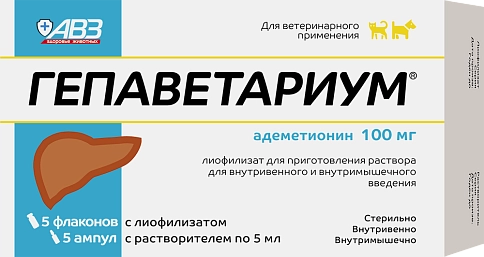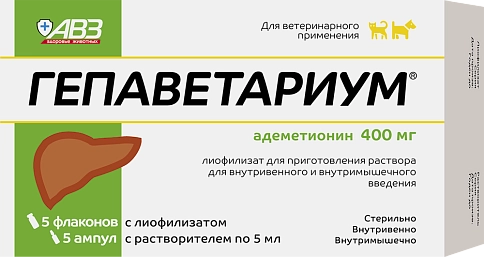Gepavetarium for injection
Composition and pharmacological properties.
GEPAVETARIUM® is available in dosages of 100 mg and 400 mg of ademethionine.Composition: Active substance: Lyophilizate:
GEPAVETARIUM® 100 mg: 1 vial of lyophilizate contains ademethionine 1,4‑butandisulfonate 190 mg, which corresponds to 100 mg of ademethionine;
GEPAVETARIUM® 400 mg: 1 vial of lyophilizate contains ademethionine 1,4‑butandisulfonate 760 mg, which corresponds to 400 mg of ademethionine;
Auxiliary substances: Solvent
The 5.0 ml ampoule contains: L – lysine 342.4 mg, sodium hydroxide 11.5 mg and water for injection.
GEPAVETARIUM® belongs to the group of hepatoprotectors with antidepressant activity. It has a choleretic and cholekinetic effect. It has detoxifying, regenerating, antioxidant, antifibrosing and neuroprotective effects.
It replenishes the deficiency of ademethionine and stimulates its production in the body, primarily in the liver and brain. Participates in biological transmethylation reactions (metal group donator) – a molecule of S-adenosyl-L-methionine (ademethionine) donates the methyl group in the methylation reactions of cell membrane phospholipids, proteins, hormones, neutromediators, etc.; transulfation – a precursor of cysteine, taurine; glutathione, provides the redox mechanism of cellular detoxification), coenzyme A.
Increases the content of glutamine in the liver, cysteine and taurine in plasma; reduces the content of methionine in blood serum, normalizing metabolic reactions in the liver. After decarboxylation, it participates in the processes of aminopropylation as a precursor of polyamines – putrescine (a stimulator of cell regeneration and proliferation of hepatocytes), spermidine and spermine, which are part of the ribosome structure. It has a choleretic effect due to increased mobility and polarization of hepatocyte membranes due to stimulation of phosphatidylcholine synthesis in them. This improves the function of bile acid transport systems associated with hepatocyte membranes and promotes the passage of bile acids into the biliary system.
It is effective in the intra-lobular variant of cholestasis (violation of the synthesis and flow of bile). Promotes detoxification of bile acids, increases the content of conjugated and sulfated bile acids in hepatocytes. Conjugation with taurine increases the solubility of bile acids and their excretion from the hepatocyte. The process of sulfating bile acids promotes their elimination by the kidneys, facilitates passage through the hepatocyte membrane and excretion with bile. In addition, sulfated bile acids additionally protect the membranes of liver cells from the toxic effects of unsulfated bile acids present in high concentrations in hepatocytes during intrahepatic cholestasis.
Indications for use.
GEPAVETARIUM® is prescribed independently or as part of complex therapy for the following diseases of dogs and cats:· hepatitis of various genesis: viral, toxic; fatty liver;
· cholangitis;
· intrahepatic cholestasis;
· chronic non-calculous cholecystitis;
· to reduce the negative effects of drugs with hepatotoxicity.
Indications for the forced use of a veterinary drug:
The drug GEPAVETARIUM® is used to reduce the negative effect of drugs with hepatotoxicity in hepatitis of various genesis: viral, toxic; fatty liver dystrophy; in chronic non-calculous cholecystitis, cholangitis.
Contraindications.
The drug GEPAVETARIUM® should be used with caution during pregnancy and lactation, as prescribed by a veterinarian.The order of application.
GEPAVETARIUM® is used for animals starting from 3 months of age.GEPAVETARIUM® is administered intravenously or intramuscularly 1 time a day at a dose of 20 mg / kg of the active substance, which corresponds to 0.25 ml / kg of animal weight.
The course of treatment is 7-14 days.
Lyophilizate should be dissolved in a specially supplied solvent immediately before administration. To do this, a solvent is collected with a sterile syringe and, in compliance with the rules of asepsis, injected into a vial with lyophilizate. For a dosage of 100 mg, 1.25 ml of solvent should be selected, for a dosage of 400 mg, the entire solvent from the ampoule should be used. The solvent should be selected with a syringe, the volume of which does not exceed 2 volumes of the selected volume. Solvent residues are not subject to further storage.
When administered intravenously, strict adherence to the rules of asepsis is necessary.
Side effects.
In therapeutic doses, the drug does not cause any side effects.With increased individual sensitivity of the animal to the components of the drug and the occurrence of allergic reactions, the use of the drug is discontinued and antihistamines and symptomatic therapy are prescribed to the animal.
Special instructions.
GEPAVETARIUM® is not intended for use by productive animals.Keeping.
The drug should be stored in the manufacturer's closed packaging, in a dry place protected from direct sunlight, separately from food and feed at a temperature of 2 ° C to 25 ° C.It should be kept out of the reach of children.
Shelf life under storage conditions: lyophilizate – 2 years.
The date of production of lyophilizate is the end date of the lyophilization process; solvent – 3 years. The date of solvent production is the date of solvent packaging.
After opening the bottle, the drug is not subject to storage!

The information provided in this catalog is for reference only. There may be some changes in the characteristics, packaging and packaging of products.
AVZ reserves the right to make such changes without notice. You can get full information about the updated products from your personal manager or your nearest AVZ dealer.
All drugs for veterinary use from this catalog may be contraindicated and when using it is necessary to familiarize yourself with the Instructions for Use.

















